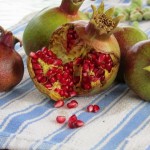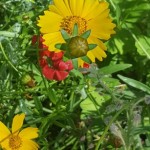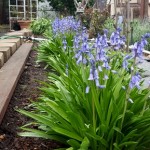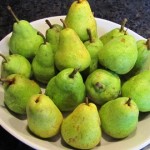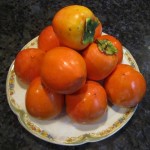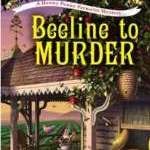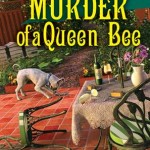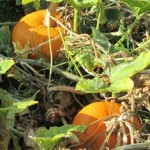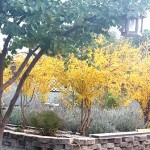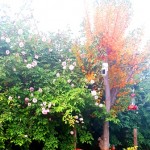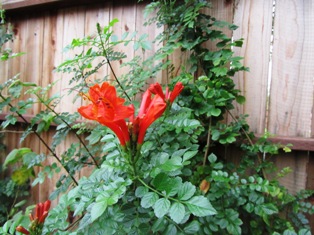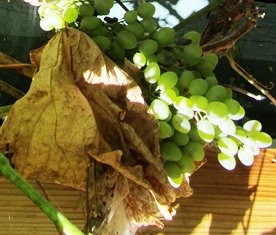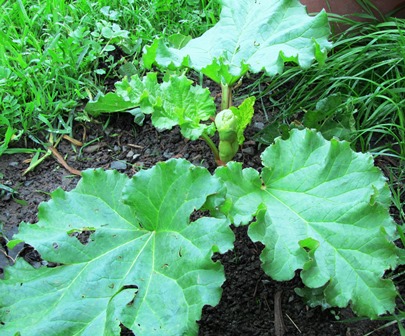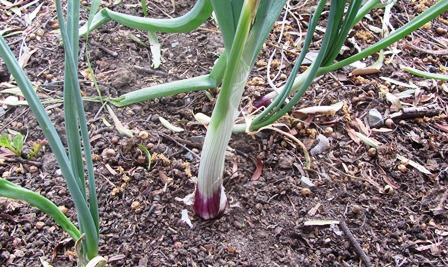A CHORES LIST FOR THE AUTUMN GARDEN
Each year on the first day of autumn here on the Henny Penny Farmette, I take stock of my fruit trees and vegetable and flower gardens.
The Old Farmer’s Almanac points to mid-October 2019 for early rain in Northern California, so there’s much for me to do over the next two or three weeks.
- Nothing says “autumn” like ripe pomegranates
My chores list includes the following items. They’re roughly the same from year to year.
1. Gather seeds from self-seeding or heirloom, open-pollinated plants (flowers and vegetables) for next year’s garden. Dry seeds and store them for planting next spring.
2. Sow spring-blooming bulbs (such as daffodils, tulips, hyacinths, ranunculus, crocus, and buttercups available in garden centers now).
3. Turn soil and prepare beds for the cool-season vegetable garden (broccoli, cabbage, beets, and parsnips).
4. Inspect and divide perennials.
5. Harvest olives and preserve them.
6. Pick late summer pears and ripe pomegranates. The leathery covering of pomegranates already may be splitting open and showing ruby red seeds. The juice of the seeds makes a wonderful jelly.
7. Check persimmons for ripeness. Pick if they’re ready. They might need another month.
8. Harvest and store pumpkins and butternut squash. Peel, remove seeds, and cut the flesh into squares for freezing.
9. Compost old garden vines and vegetable plants that are done bearing for the season. Check tomato plants infected with bacterial or fungal diseases and do NOT add any of these to the compost pile.
10. Begin the process of cleaning and storing gardening items not required over the winter.
11. Sow spring-blooming wildflowers in prepared beds.
12. Schedule time to prune back crop-bearing fruit trees (like apricot, peach, and plum).
I actually look forward to those chores. They’re part of the natural rhythm of farmette life. With a list and plan to get everything done, I won’t be caught by surprise when the weather turns cold, dark, and rainy.
________________________________________________________________________________________________
If you enjoy reading about farming, country living, keeping of bees and chickens, and gardening, check out my Henny Penny Farmette series of cozy mysteries. They’re chocked full of ideas, tips, and delicious recipes for country living.
Also, take a look at my numerous self-help and wellness books. All are available at Amazon.com, Barnes & Noble.com, Walmart.com, and other online and traditional bookstores everywhere.

More than 150 rituals for sound mind, strong body, and meaningful connections to the people around you
Celebrate the Ever-Evolving Garden
There’s nothing to rejuvenate a weary soul like time spent in a garden. Death of one season’s plants yields to new shoots the next. Because I appreciate the ever-evolving nature of a garden, I choose plants, bulbs, bushes, and trees that offer visual interest in each season. Thoughtful planting generates an ever-evolving landscape of color, texture, and visual interest.
The autumn garden has almost completely morphed into a winter landscape now. Pumpkin and tomato vines have been pulled out and perennials in the bee garden have gone to seed or been cut back. Winter offers little color in the garden except for the cape honeysuckle, white geranium, lavender florets, and early flowering bulbs.
Deciduous trees have mostly lost their leaves, however, the eucalyptus and the pepper trees here on the farmette remain leafy and green. The rains have come and a dusting of snow on nearby mountain peaks is in the forecast ahead. Foliage and blooms are mostly gone. It’s that time of year to cover frost-sensitive plants.
The pomegranates that were ablaze in golden color a few weeks ago have dropped all leaves. What remains is the lovely arching pattern of branches since I’ve trained them from bushes into trees.
The showy pink flowers over summer of the crape myrtle are a memory. Gone now, too, are the red-gold leaves of fall. What remains is an interesting gray-green bark.
The seeds from the giant yellow-orange coreopsis that stood eight feet tall and towered over zinnias, Borage, and rows of lavender have long ago been harvested. Also, my patch of lavender is flourishing. The plants have pushed out long stalks of purple florets.
Dark green shoots of bulbs are pushing up out of the earth where I interplanted them with chrysanthemums. I cut back the mums and they will reappear in the spring to flower again. This is the time of year that shoots of bulbs and rhizomes are birthing daffodils, anemones, tulips, hyacinths, and, to come later, lilies and irises of many colors.
In raised beds, shoots of fall-planted onions and garlic are now pushing up. The bees are drawn to the sweet scent of narcissus bulbs that have naturalized after being planted years ago. The Meyer lemon now has lots of yellow thin-skinned fruit and also a few early blooms.
On the dark days and nights of winter, white blooming plants stand in stark contrast to gray wooden fences and leafless trees. Honor roses, Iceberg roses, and climbing Sally Holmes roses have showy white blooms and may even have some this time of year unless they’ve been cut back. Winter-blooming gardenias and white geraniums have a quiet impact when grouped together in hedges, beds, or containers.
With so many bulbs and plants available this time of year, putting interest into your winter garden is easy and contributes to an ever-evolving landscape.
Consider plants with gray-green or otherwise pretty foliage and colorful berries. Also plant trees with interesting bark colors, textures, patterns, or scaffolding shapes. When you think of plants for each season of the year, you’ll have a garden to nurture you throughout the year.
____________________________________________________
If you enjoy reading about gardening, the keeping of chickens and bees, and other small farm topics AND you’d like related gift-giving, consider my Henny Penny Farmette series of cozy mysteries or any of my health, wellness, and spirituality books. All are available online and in traditional bookstores everywhere.
AVAILABLE NOW. Tap control click in the following link: https://www.amazon.com/How-Live-Intention-Meaning-Purpose-ebook/dp/B07GNVFWSF/ref=sr_1_1?ie=UTF8&qid=1544206797&sr=8-1&keywords=Meera+Lester%2BHow+to+Live+with+Intention
To Purchase, tap control click on the link:
How to Attract Hummingbirds to Your Garden
Here on the Henny Penny Farmette, we love watching the spectacular aerial maneuvers of male hummingbirds attempting to attract the interest of a nearby female. These gorgeous feathered flirts know how to bedazzle a potential mate with spectacular maneuvers that show off the intense coloring of their iridescent feathers.
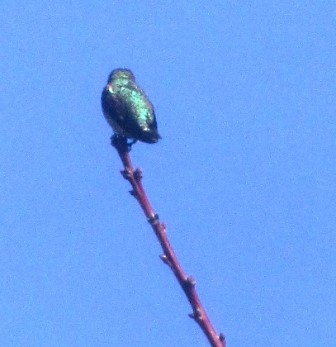
A hummer’s iridescent feathers shimmer as it perches in sunlight at the end of an apricot tree branch
Depending on the species, these tiny birds can flutter their wings in a figure eight pattern (they don’t flap them) from 12 to 80 times per second. All that fluttering requires tremendous energy.

Hummers are attracted by the intense hue of certain flowers such as nasturtiums and the promise of nectar
Hummers mainly get their energy from plants with brightly colored, nectar-rich flowers. They will dine at hummingbird feeders filled with red sugar-water and hung around gardens that feature plants with brightly colored blooms, especially if those blooms are high in nectar. The following is a list of plants known to attract hummingbirds.
- Impatien
- Nasturtium
- Phlox
- Nicotiana (flowering tobacco)
- Salvia (scarlet sage)
- Snapdragon
If you like plants that return each year, tuck in these brightly colored perennials.
Alcea rosea
- Aloe
- Bee Balm
- Columbine
- Coral Bell
- Four-o-clock
- Gladiola
- Penstemon
- Phlox
- Salvia
Shrubs such as the butterfly bush (Buddleia) and the flowering maple, hibiscus, and rosemary hold a special appeal for the hummers. They also will be attracted to blooming vines (especially those with trumpet or tube-shaped flowers in intense colors). Tuck in Cape honeysuckle, flame vine, or the blood-red trumpet creeper and watch the hummers darting in and around these vines from dawn until dusk. For more ideas, visit your local nursery or birding store.
* * *
Do you enjoy reading about farming topics? Check out my cozy mysteries–A BEELINE TO MURDER and also THE MURDER OF A QUEEN BEE (both in the Henny Penny Farmette series from Kensington Publishing).
My farm-based novels feature delicious recipes, farming tips, chicken and beekeeping tips, sayings and, of course, a charming cozy mystery. For more info, click on the links under the pictures.
The books are available through online retailers such as Amazon, Barnes & Noble, Target, BAM, Kobo Books, and Walmart as well as from traditional bookstores everywhere.
See, http://tinyurl.com/hxy3s8q
A Beeline to Murder is the debut novel that launched the Henny Penny Farmette series of mysteries. Initially released as a hardcover novel and in e-book format, it is now available as a mass market paperback.
See, http://tinyurl.com/h4kou4g
NEWLY RELEASED! This, the second cozy mystery in the Henny Penny Farmette series, is garnering great reviews from readers and industry publications.
Gardening Tasks for Late Autumn
Falling leaves, shorter days, and colder weather signal that winter is around the corner. With roughly a month left before winter officially begins, there are plenty of tasks for the home gardener. Don’t put away your boots, buckets, gloves, trowel, and spade just yet.
If you grow grapes and raspberries or blackberries, now would be the time to prune those back before mulching with compost, leaves, or sawdust. Composting suppresses weed growth.
Pick and pumpkins, apples, and winter squash. Store them in a dry area at temperature of about 50 degrees Fahrenheit.
Rhubarb plants can be divided now. Make sure there’s an eye on each new plant and tuck into rich soil and mulch.
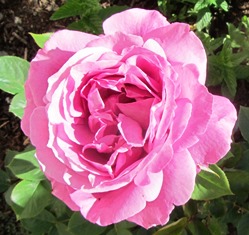
This candy-stripe rose requires a good pruning in the fall to generate a large bush with beautiful blooms in the spring
Remove leaves and prune back roses to 12 to 18 inches. Add some bone meal to the base of the bush and work into the soil.
Plant bulbs that will flower in the spring such as daffodils, tulips, hyacinth, crocus, and scillas.
Prepare a bed for onion seedlings or sets and plant them now for spring harvesting.
Fill bird feeders, hang a warming light in your hen house for the freezing nights ahead, and put blankets around your bee hives.
Transfer potted mums into garden soil. Most are perennials and will return year after year.
Plant kale, ornamental cabbage, and winter-hardy plants such as pansies in the garden or window boxes for winter color.
Move cold-sensitive houseplants indoors.
 Facebook
Facebook Goodreads
Goodreads LinkedIn
LinkedIn Meera Lester
Meera Lester Twitter
Twitter






